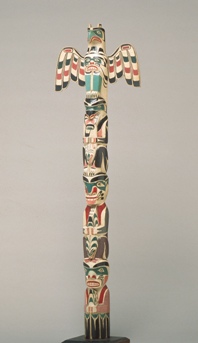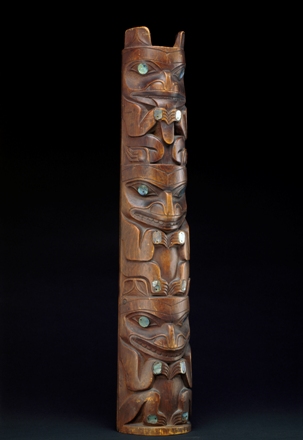SAM Art: A model, a saga, a lecture
The small-scale totem pole is an indigenous genre that pre-dates contact: Captain James Cook personally collected one at Nootka Sound in 1778. Some model poles are diminutive, specific versions of the forty- to sixty-foot poles erected to honor the lineages of deceased chiefs and nobles. Small-scale examples of Native longhouses with totem poles erected in front were commissioned by anthropologists for World’s Fair and museum displays. By the mid-19th century, these easily portable and compelling sculptures were in steady demand by outside buyers, as they are today.
A master carver of ceremonial arts, nearly all of Hemasilakw’s life was shadowed by the potlatch ban. He pushed the traditional origins of his art style toward distinctively modern refinements, evidenced in the bold sculptural forms and exuberant painting of his full-size poles. Even his model poles powerfully convey the personalities of each mythic figure.
Joseph Hillaire and the Saga of the 1962 Seattle World’s Fair Totems with Barbara Brotherton
Members Art History Lecture Series: New Perspectives
March 21, 2012
7:00–9:00 pm
Plestcheeff Auditorium, SAM downtown
Model Totem Pole, early 20th century, Arthur Shaughnessy (Hemasilakw) (Kwakwaka’wakw, Dzawada’enuxw, Kingcome Inlet, 1884–1945), wood and pigment, 36 ¾ x 10 ¼ x 5 ¾ in., Gift of June Bedford in honor of Steve Brown, 2000.51. Currently on view in the Native American Art galleries, third floor, SAM downtown.

